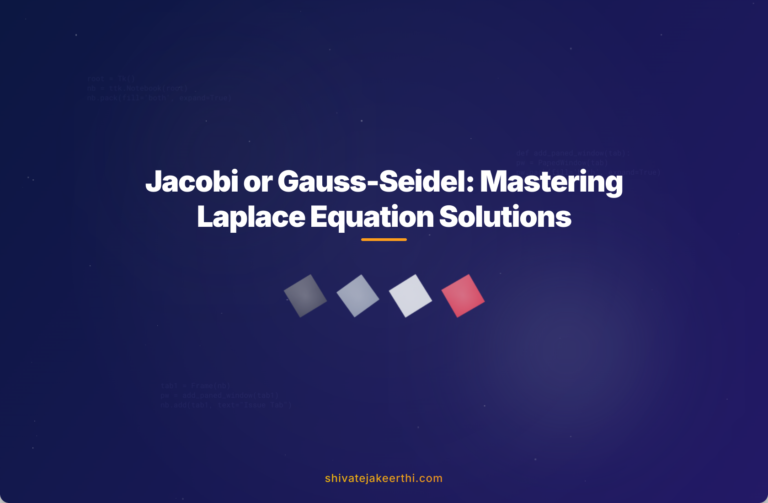When solving numerical problems, particularly partial differential equations like the Laplace equation, choosing the right iterative method can significantly affect the performance. Typically, the Gauss-Seidel method converges faster than Jacobi due to its ability to use updated values immediately. Surprisingly, however, there are cases where Jacobi seemingly converges faster, raising suspicions of underlying implementation issues.
The Laplace equation describes potentials, such as temperature, electrostatics, or fluid flow, in a region without sources or sinks. For a two-dimensional steady-state problem, it’s expressed as:
∇²φ(x,y) = ∂²φ/∂x² + ∂²φ/∂y² = 0In numerical computations, we typically discretize this PDE on a grid, utilizing finite-difference schemes to approximate derivatives. For instance, the standard finite-difference approximation for the second derivative in the x-direction looks like:
d²φ/dx² ≈ (φ[i+1,j] - 2φ[i,j] + φ[i-1,j]) / Δx²Implementing boundary conditions correctly sets the stage for accurate results. For a square domain, boundary conditions usually involve fixed values or derivative approximations. Iterative methods update interior grid points repeatedly until residual errors drop below a chosen tolerance, typically checked as the difference between successive iterations.
Let’s first clearly describe the Jacobi method to identify possible implementation pitfalls. Jacobi’s method updates each grid cell simultaneously based strictly on values from the previous iteration alone. For instance, consider a square grid:
- Initialization: Set initial guess values and boundary values.
- Iteration: Update each internal node using a simple average of its four immediate neighbors from the previous iteration.
- Convergence check: Terminate iteration once the change (residual) between iterations is below a predefined tolerance.
An explicit implementation example in Python might look like:
for i in range(1, nx-1):
for j in range(1, ny-1):
T_new[i,j] = 0.25 * (T_old[i+1,j] + T_old[i-1,j] + T_old[i,j+1] + T_old[i,j-1])A common implementation issue causing unusual faster convergence in Jacobi than Gauss-Seidel originates from accidentally mixing updated current values (like in Gauss-Seidel) into Jacobi iterations. Such confusion often manifests as unexpectedly quicker convergence but misleading accuracy. Accurate Jacobi implementation strictly uses previous iteration arrays only—never current values mid-update.
When Jacobi appears to outperform Gauss-Seidel, there’s typically an underlying discrepancy. Jacobi typically converges more slowly because it doesn’t take advantage of the most recently updated values. In contrast, the Gauss-Seidel method immediately incorporates each new updated grid point into subsequent calculations:
- Gauss-Seidel method: Each node update incorporates already-updated neighboring values from the current iteration, improving convergence.
- Jacobi method: Updates occur simultaneously with values strictly from the previous iteration, typically leading to slower convergence.
Another factor affecting convergence rate includes grid problem structure, initial guesses, relaxation techniques, and boundary handling. Even small unintended errors can affect results dramatically. Debugging iterative numeric codes requires a systematic approach like:
- Ensure correct indexing: Out-of-bound indices may incorrectly access unintended values, affecting convergence.
- Check proper initialization: Confirm boundary conditions and initial guesses are correctly set.
- Monitor residual calculation: Accurately compute residual or norm to assess convergence (example on Stack Overflow).
- Validate matrix symmetry and discretization correctness: Verify mathematical formulation in code.
Common pitfalls observed in Jacobi implementations include:
- Mixing iterations unintentionally: True Jacobi strictly uses prior timestep values. Even a small oversight results in an inconsistent or falsely accelerated convergence rate.
- Incorrect boundary approximation: Derivative boundary conditions improperly implemented using finite-difference methods could distort convergence behavior.
- Inaccurate residual calculation: Ensuring the correct residual or convergence criterion is paramount. A wrong norm or threshold may misrepresent the true convergence status.
How do we address such discrepancies? Start by double-checking the iterative algorithm implementation. Clearly separate iteration arrays:
# Correct Jacobi update pattern
T_new[1:-1,1:-1] = 0.25 * (T_old[2:,1:-1] + T_old[:-2,1:-1] + T_old[1:-1,2:] + T_old[1:-1,:-2])
Gauss-Seidel updates would differ—it uses values immediately as they become available:
# Correct Gauss-Seidel update approach
for i in range(1, nx-1):
for j in range(1, ny-1):
T[i,j] = 0.25*(T[i+1,j] + T[i-1,j] + T[i,j+1] + T[i,j-1])Experimental validation of convergence behaviors helps rule out such pitfalls definitively. A recommended approach involves testing various initial conditions to confirm robustness. Compare numerical results with known analytical solutions when available to validate accuracy. For instance, using a known benchmark solution from a textbook or reputable source helps confirm numerical correctness.
Furthermore, performing sensitivity analysis or parameter sweeps provides insights into how boundary condition approximations or discretization schemes impact the solution’s stability and convergence patterns. Visualization using heatmaps or line plots over iterations clearly identifies convergence characteristics, helping pinpoint errors visually and quantitatively.
By employing optimized strategies like Successive Over-Relaxation (SOR) or under-relaxation techniques, you can accelerate convergence significantly. For example, SOR modifies Gauss-Seidel by adding relaxation:
T[i,j] = (1-ω)*T[i,j]+(ω/4)*(T[i+1,j]+T[i-1,j]+T[i,j+1]+T[i,j-1])Choosing the optimal relaxation factor ω improves convergence efficiency dramatically.
Ultimately, identifying the Jacobi method’s unexpected performance involves systematically reviewing and correcting implementation details. While the method is straightforward, its performance heavily relies on precise implementation steps. Comprehensive numerical testing ensures better validation and accurate results.
By understanding and correcting such common pitfalls, the Jacobi method can serve as a reliable computational tool for solving Laplace and similar equations. For further learning and practicing Python implementations for PDE numerical solutions, check out more Python content and tutorials here.
Have you encountered similar convergence issues in your numerical simulations? Share your experience or questions in the comments below!



0 Comments